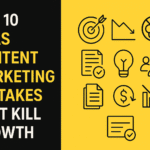In today’s digital world, where content is king, two key forces drive online success: SEO and Content Writing. Though distinct, they are deeply intertwined, working together to attract, engage, and convert audiences.
SEO (Search Engine Optimization) focuses on the technical strategies that make content discoverable by search engines, while Content Writing is the craft of creating engaging, valuable, and reader-centric material. Together, they form the foundation of effective digital marketing.
But what sets them apart? More importantly, how do they complement each other to achieve shared goals? In this article, we’ll break down the unique roles of SEO and Content Writing, their differences, and why mastering both is crucial for standing out in today’s competitive market.
SEO Writing: The Science of Visibility
SEO writing is like building a bridge between your content and search engines. It ensures that your content is not only found but also ranks well in search results. Here’s a more detailed look:
1. Keyword Research:
- SEO writing starts with identifying the right keywords. These are the terms your target audience is typing into search engines.
- Tools like Google Keyword Planner, Ahrefs, or SEMrush help you find high-volume, low-competition keywords.
Example: If you’re writing about “healthy breakfast ideas,” you might target long-tail keywords like “quick healthy breakfast recipes for busy mornings.”
2. On-Page Optimization:
This involves strategically placing keywords in your content without overstuffing. Key areas include:
- Title Tag: The headline that appears in search results (e.g., “10 Quick Healthy Breakfast Recipes for Busy Mornings”).
- Meta Description: A short summary that entices users to click (e.g., “Discover 10 easy and healthy breakfast recipes perfect for busy mornings. Start your day right!”).
- Headers (H1, H2, H3): Organize your content and include keywords naturally.
- Alt Text for Images: Describe images for accessibility and SEO (e.g., “bowl of oatmeal with fresh berries”).
3. Technical SEO:
SEO writing isn’t just about words; it’s also about how your content is structured and delivered. This includes:
- Page Speed: Fast-loading pages rank better.
- Mobile-Friendliness: Content must look good on all devices.
- Internal Linking: Connect related content to improve navigation and SEO.
- Structured Data: Use schema markup to help search engines understand your content (e.g., recipes, FAQs).
4. Search Intent:
- SEO writing requires understanding why someone is searching for a particular term. Are they looking for information, a product, or a solution to a problem?
- Example: For the keyword “best running shoes,” the intent might be informational (reviews) or transactional (buying).
Content Writing: The Art of Engagement
Content writing is about creating meaningful, valuable, and engaging content that resonates with your audience. It’s the human side of the equation. Here’s a deeper dive:
1. Understanding Your Audience:
- Great content starts with knowing who you’re writing for. What are their pain points, interests, and goals?
- Example: If your audience is busy professionals, they might appreciate time-saving tips or actionable advice.
2. Storytelling and Structure:
Content writing is about crafting a narrative that keeps readers hooked. This includes:
- A compelling introduction to grab attention.
- Clear, logical flow with subheadings and bullet points for readability.
- A strong conclusion that leaves an impact or includes a call-to-action (CTA).
3. Value and Relevance:
- Your content should provide real value, whether it’s solving a problem, answering a question, or entertaining.
- Example: A blog post titled “How to Save Money on Groceries Without Sacrificing Quality” offers practical tips that readers can immediately apply.
4. Tone and Voice:
- The tone of your content should match your brand and audience. It could be professional, conversational, humorous, or authoritative.
- Example: A fitness brand might use an energetic and motivational tone, while a financial advisor might opt for a more formal and trustworthy voice.
5. Visual and Interactive Elements:
Content writing isn’t just about text. It includes:
- Images, infographics, and videos to break up text and enhance understanding.
- Interactive elements like quizzes or calculators to engage users.

Why You Need Both: The Synergy
SEO and content writing are like the engine and the fuel of a car. One won’t work effectively without the other.
1. SEO Brings the Traffic:
- Without SEO, even the best content might go unnoticed. SEO ensures your content is discoverable by the right people at the right time.
- Example: A well-optimized blog post about “vegan meal prep ideas” can attract thousands of visitors searching for that topic.
2. Content Writing Keeps the Audience Engaged:
- Without great content, visitors might leave your site quickly, increasing bounce rates and hurting your SEO.
- Example: A poorly written article with no clear structure or value will frustrate readers, even if it ranks well.
3. Together, They Build Authority and Trust:
- High-quality, optimized content positions you as an authority in your niche. Over time, this builds trust with both search engines and your audience.
- Example: A blog that consistently publishes well-researched, SEO-optimized articles on “digital marketing tips” will become a go-to resource for readers and rank higher in search results.
How to Balance SEO and Content Writing
1. Start with Research:
- Use tools like Google Trends, AnswerThePublic, or BuzzSumo to find topics your audience cares about.
- Combine this with keyword research to identify opportunities.
2. Write for Humans, Optimize for Search Engines:
- Focus on creating content that’s engaging and valuable first, then tweak it for SEO.
- Example: Write a helpful guide on “how to start a blog,” then add keywords like “best blogging platforms” or “blogging tips for beginners.”
3. Use Data to Improve:
- Analyze your content’s performance using tools like Google Analytics or Search Console.
- See which pages are ranking well and which need improvement, then update them accordingly.
4. Experiment and Iterate:
- SEO and content writing are not one-time tasks. Continuously test different approaches, update old content, and stay updated with industry trends.
Conclusion
SEO writing is the technical side that ensures your content is visible, while content writing is the creative side that ensures your content is valuable and engaging. Together, they form the foundation of a successful digital strategy.
In our opinion it should not be content vs SEO, rather they both should help you boost visibility. If you need help with content or SEO you can talk to us, we offer services related to SEO writing and blog writing. You can check our website for the same, the first call is of no charge.







Leave a Reply